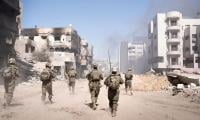On October 27, the US Special Operations forces killed the dreaded leader of the Islamic State (IS), Abu Bakr Al-Baghdadi, in Syria’s Idlib province. This is the second major setback to IS and its worldwide network in 2019.
In March, the loss of Baghouz in Syria marked the end of the terror group’s territorial caliphate. The killing of Baghdadi has deprived the group of both the self-declared caliph and the caliphate.
The raid followed a month-long intelligence operation that monitored a smuggler who moved the wives of two of Baghdadi’s brothers Jumah and Ahmad, along with other family members, to Idlib. Surprisingly, Idlib is a stronghold of Al-Qaeda affiliated Huras Al-Din and Hayat Tahrir al-Sham (HTS), where IS operatives have been routinely killed and captured by these two groups.
In any case, Baghdadi’s killing will operationally weaken the already embattled IS and hamper its slow recovery – enabled by the sudden pullout of 1,000 US troops from north-eastern Syria and the subsequent Turkish incursions in the area. The Turkish raids have displaced the Kurdish Syrian Democratic Forces (SDFs) who were guarding the prisons where captured IS fighters and their families were incarcerated.
Baghdadi has left a mixed legacy. Like his grand predecessor and founder of the Al-Qaeda in Iraq (AQI) Abu Musab Al-Zarqawi, Baghdadi will go down in the history of the global jihadist movement as a controversial and divisive figure with extreme sectarian tendencies. He was so violent that even Al-Qaeda, the Taliban and Al-Shabab decried his violent methods. Blame for the weakening of the global jihadist movement will also be pinned on Baghdadi.
At the same time, Baghdadi was a charismatic leader, an eloquent speaker and a larger than life figure. He has achieved what no other global jihadist leader has achieved to date – founding the so-called caliphate in the heart of the Arab world that stretched over 88,000 square kilometers from Mosul in Iraq to Raqqa in Syria.
Baghdadi also revolutionised the use of different social media platforms for recruitment and dissemination of extremist propaganda. He was instrumental in galvanising around 41,490 foreign fighters from 80 countries – including 32,809 men, 4,761 women and 4,640 children – to join IS in Iraq and Syria. Though Baghdadi could not pull off a 9/11-type attack, he was instrumental in inspiring and directing the highest number of terrorist attacks against the West.
His successor will not only have to fill in the leadership vacuum created by his elimination and keep the IS intact, but he will also have to seek pledges of allegiance from the group’s worldwide affiliates.
If Baghdadi’s successor fails to inspire confidence and command the respect of IS affiliates, they might shift their loyalties towards Al-Qaeda. Ideologically, Baghdadi’s death has freed them from their oaths of allegiance, and it is not binding on them to pledge allegiance to his successor as well. Abdullah Qardash, a former Iraqi military officer, who was appointed as Baghdadi’s deputy in August due to his poor health, is likely to succeed him.
Unlike Osama bin Laden who was shot in the head by US Navy Seals in Abbottabad in 2011, Baghdadi took his life by detonating the suicide vest strapped to his body instead of being killed or captured. In the April 2019 video, Baghdadi’s carefully choreographed image showed an assault rifle and a suicide vest placed next to him. The IS will spin Baghdadi’s martyrdom as a propaganda tool to inspire reprisal attacks and boost fresh recruitments. IS-linked Telegram channels are portraying Baghdadi’s killing as the fulfillment of the ultimate goal and desire of a jihadist: martyrdom.
Baghdadi’s elimination has also opened up the possibility (albeit remotely) of IS and Al-Qaeda reunion. Both groups have similar ideological outlooks and goals. They differ over strategy (the former sees the creation of the caliphate as the starting point of jihad, while the former considers it as the ultimate outcome of jihad). Likewise, both had leadership dispute and a personality clash. Both Baghdadi and Zawahiri claimed to be the true successor of Bin Laden. With Baghdadi’s removal, the reunification of the global jihadist movement under Zawahiri cannot be ruled out.
The IS is an ideologically resilient organization which has survived leadership decapitation in the past. Despite losing its founder Zarqawi in 2006 and two more leaders before Baghdadi as well as his deputy Abu Muhammad Al-Adnani in 2016, the IS has remained intact. In adverse circumstances, it has proven to be operationally adaptable and ideological flexible with tremendous regenerative capacity.
Prior to Baghdadi’s killing, Bin Laden’s son Hamza bin Laden who was being groomed as the future of the global jihadist movement was eliminated in Afghanistan. In a way, 2019 has been a bad year both for the IS and Al-Qaeda. However, the fight against global jihad remains a work in progress.
Baghdadi’s death does not mean the death of the IS. Since territorial losses in the Middle East, the IS has focused on a warfare of narratives and ideological supremacy highlighting that “the will to wage the war is more important than winning the war.”
A terrorist organisation can recover from leadership losses and infrastructural damages. However, choking off financial sources and countering the ideological narratives permanently weakens it. As long as the IS is ideologically not discredited and its extremist narrative – still resonating with its worldwide network of supporters, sympathisers and operatives – is not targeted, the terror group will survive in one form or the other.
The writer is an associate research fellow at the S Rajaratnam School of International Studies, Singapore.
Email: isabasit@ntu.edu.sg
A representational image showing residents walking at a wholesale market in Karachi. — AFP/FileOnce again there is...
A representational image showing late Pakistani human rights activist and Supreme Court lawyer Asma Jahangir. —...
A representational image showing a security personnel sanding guard beside a ship carrying containers at Gwadar port....
A health worker administers polio vaccine drops to a child during a door-to-door polio vaccination campaign in Lahore,...
Armed militants of the banned Tehreek-e-Taliban Pakistan pose for a photograph in Orakzai Agency. —...
An aeroplane of the national flag carrier of Pakistan is seen in this file photo. — AFPWhile Pakistan considers...







